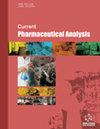Determination of Two Potential Genotoxic Impurities in Crisaborole API by UPLC-MS/MS
IF 1.5
4区 医学
Q4 PHARMACOLOGY & PHARMACY
引用次数: 0
Abstract
Atopic dermatitis (AD) is an allergic skin disease that can be inherited. Crisaborole is a specific drug developed to deal with this disease. The compounds of 4-(4-Bromo-3-formyl-phenoxy)-benzonitrile and 4-(4-(4-bromo-3-formylphenoxy)-3- formylphenoxy)benzonitrile are the representative impurities in the synthesis of Crisaborole active pharmaceutical in gradient (API). Owing to the genotoxic impurities that could lead to cancer and gene mutations, it is necessary to develop a simple, efficient, sensitive, and accurate method to detect these impurities. In this study, the 4-(4-Bromo-3-formyl-phenoxy)-benzonitrile and 4-(4-(4-bromo-3-formylphenoxy)-3-formylphenoxy)benzo- nitrile present in Crisaborole API were detected using UPLC-MS/MS. The separation was made on a ZORBAX Eclipse XDB-Pheny column (4.6 mm ×75mm, 3.5 μm) with the mobile phase of acetonitrile solution containing 0.1% trifluoroacetic acid (A) and water containing 0.1% formic acid (B) in gradient elution mode. Quantification was performed using positive ion electrospray ionization (ESI), and the contents of two compounds were determined using the multiple reaction monitoring (MRM) modes. The quantitative analytical method was fully validated with respect to linearity (r>0.9998), sensitivity, precision, accuracy (the average recovery of two impurities was 84.1% to 90.7%), and robustness. Three batches of samples were detected by UPLC-MS/MS, indicating that the proposed approach was applicable for the quality evaluation of Crisaborole.hplc -MS/MS法测定Crisaborole原料药中两种潜在遗传毒性杂质
特应性皮炎(AD)是一种可遗传的过敏性皮肤病。Crisaborole是为治疗这种疾病而开发的一种特效药。4-(4-溴-3-甲酰基苯氧基)-苄脒和4-(4-(4-氯-3-甲酰基苯基氧基)-3-甲酰基酚氧基)苄脒的化合物是Crisaborole活性药物梯度合成(API)中的代表性杂质。由于遗传毒性杂质可能导致癌症和基因突变,因此有必要开发一种简单、高效、灵敏和准确的方法来检测这些杂质。在本研究中,使用UPLC-MS/MS检测API中存在的4-(4-溴-3-甲酰基-苯氧基)-苄腈和4-(4-(4-溴-3-甲酰基苯氧基洗脱模式。使用正离子电喷雾电离(ESI)进行定量,并使用多重反应监测(MRM)模式测定两种化合物的含量。该定量分析方法在线性(r>0.9998)、灵敏度、精密度、准确度(两种杂质的平均回收率为84.1%至90.7%)和稳健性方面得到了充分验证。UPLC-MS/MS检测了三批样品,表明该方法适用于Crisaborole的质量评价。
本文章由计算机程序翻译,如有差异,请以英文原文为准。
求助全文
约1分钟内获得全文
求助全文
来源期刊
CiteScore
1.50
自引率
0.00%
发文量
85
审稿时长
3 months
期刊介绍:
Aims & Scope
Current Pharmaceutical Analysis publishes expert reviews and original research articles on all the most recent advances in pharmaceutical and biomedical analysis. All aspects of the field are represented including drug analysis, analytical methodology and instrumentation. The journal is essential to all involved in pharmaceutical, biochemical and clinical analysis.

 求助内容:
求助内容: 应助结果提醒方式:
应助结果提醒方式:


